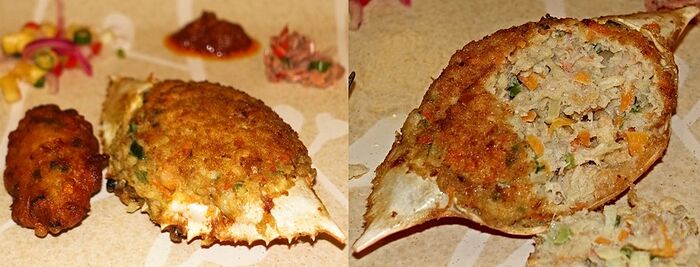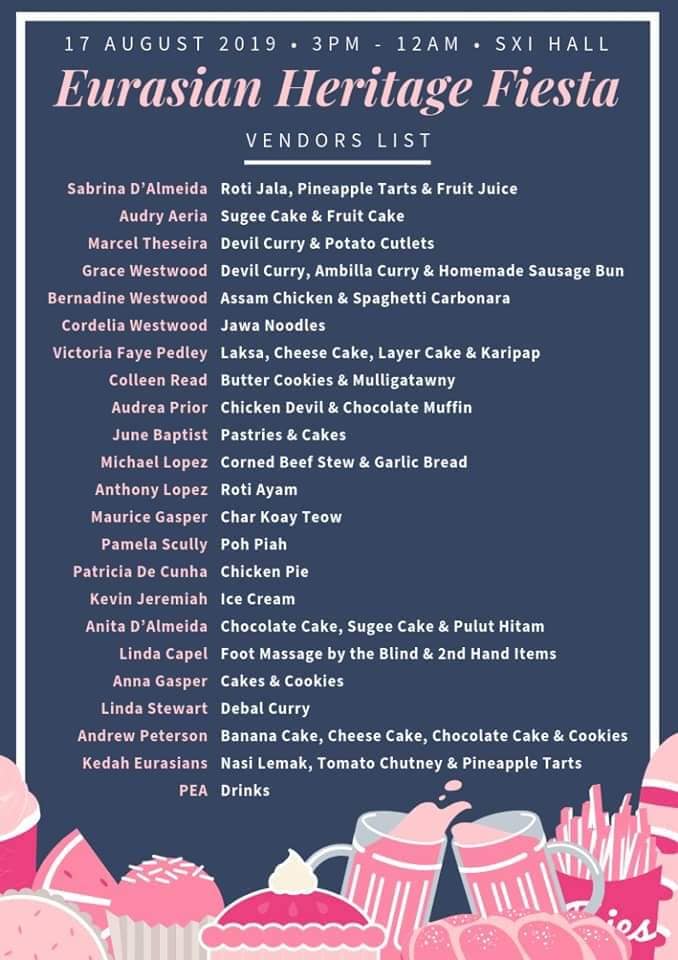Kristang cuisine, which encompasses Portuguese, Dutch and British influences, is a distinct regional cuisine by itself in Singapore and Malaysia. Its long history stretched back to the 16th-century, when Portuguese conquistadors overthrew the Sultanate of Malacca and settled there, creating a Creole Portuguese community. Malacca was a Portuguese colony from the time of its conquest in 1511 until 1641, when the Dutch East Indies Company’s fleet defeated the Portuguese armada and ransacked the Portuguese’s Fortaleza de Malaca. The Dutch subsequently stayed for nearly two centuries before the British took over Malacca in 1821, to become part of its British Malaya domain. Consequently, one finds Eurasians with surnames like Da Costa, Sequeira, Carvalho, Santa Maria, Pereira, alongside van Huizen and Oosterhuis, all a testimony to Malacca’s long, colourful history. During the British’s more than two centuries of colonial rule over Malaya, the Eurasians spread from Malacca to Penang in the north and Singapore in the south, as the 3 states make up the British Straits Settlements.
The Portuguese-Eurasian community is most distinct in Malacca, and its popular cuisine has well-known dishes like Curry Debal, Beef Smore, Feng, Pang Susi and many more, which has become an indelible part of the Singaporean/Malaysian culinary landscape.
Melba Nunis (we all called her “Auntie Melba”) was a Malaccan-born former restaurateur - she ran Simply Mel’s in Kuala Lumpur from 2011 to 2016, before shuttering it to move to Malacca and headed the Mansion at the Majestic Hotel there for two years. These days, Auntie Melba has chosen the quieter life and runs a supper club (which she calls Dine with Mel) at her home in Kuala Lumpur. She’d also written the Kristang Family Cookbook which listed down all the Portuguese-Eurasian dishes in her repertoire. Auntie Melba’s essentially Kuala Lumpur’s answer to Singapore’s Mary Gomes (author of The Eurasian Cookbook, and who runs Mary’s Kafe).
A foodie friend organised a group of us to try out Melba Nunis’ supper club last Thursday. Auntie Melba cooks for a minimum of 6 persons, but we managed to muster a party of 10 (she caps her supper club party size at 12).
66-year-old Auntie Melba was a “hostess with the mostest” tour de force - in-between dishing out her home-cooked fare, she filled us in with anecdotes, origins of the dishes we had, cooking secrets, etc. Her newly-minted supper club joins a handful of others in Kuala Lumpur, catering to those of us who are tired of run-of-the-mill KL eateries. Whilst Auntie Melba has set menus for us to select from, she was also open to tailoring the menu with any particular dish we’d want to have. What we had that evening - all the food were served on communal platters:
STARTERS
- Incimintu karangezu - these are crabshells, stuffed with a mixture of crabmeat, prawns, minced pork, jicama, carrots, onions & scallions. The stuffed crab were light and moist, very flavoursome on their own, even without the accompanying dips/relishes that came with it.
Selection of dips & relishes: two types of sambals (chili paste with lime), salted fish pickle, cincalok (fermented krill) with onions/chilis, and a deliciously piquant pineapple-cucumber relish dressed in sambal belacan.
- Auntie Mel also served some plump onion fritters, speckled with chopped red chilis and scallions.
MAINS
3) Bacon bone Kari Debal (Devil Curry) - “Debal” is a Kristang-Creole word meaning ‘leftovers’ as this ultra-spicy stew was cooked utilising Christmas roast leftovers in the olden days, with lots of chilis and vinegar thrown in - perhaps to also act as preservatives for the dish during pre-refrigeration times. In time, Kari Debal became the signature dish of Kristang/Eurasian cuisine, and its trademark chili-spiciness (plus some inadvertent mispronunciation early on) earned it the moniker Devil Curry, as it’s “hot as Hell”. ![]()
Devil Curry is usually cooked using chicken or pork-ribs (sometimes both), with frankfurters and potatoes thrown in. I know Singapore’s Kristang/Eurasian restaurants liked to add cabbage to the stew - but it’s probably a regional variance as Malaccan Kristang/Eurasians don’t. The version we had at Auntie Melba’s used bacon bones, which added a smokey, sweet quality to the stew, tempering its spiciness a bit.
-
Keluak curry pork- Buah keluak (also spelt “kluwek” in Indonesia, where the world’s supply comes from) is a large nut which yielded a truffle-like flesh. Used extensively in Nyonya (Straits-Chinese cooking) in Malacca and Singapore, the Kristang-Eurasians also use buah keluak for their stews. The pork-rib here was very close in taste to the Nyonya one, with chilis, galangal and tamarind added to the spicy stew.
-
Spam stiu and sambal goreng - this is an unusual but very addictive dish, basically a light stew cooked using diced Spam, potatoes, carrots, cauliflower, maccheroni and scallions, with good chicken stock, and scented with cinnamon bark and cloves. The soup watered down the saltiness of the Spam, and it was my absolute favourite dish for the evening.
-
Black sotong sambal - the squid (Malay: “sotong”) was cooked till soft, with a “rempah” (chili-spice blend), then enriched with squid’s ink. The resultant dish was dark, with a deep, mellow earthy flavour. It was hands-down THE favourite dish among my fellow diners.
-
Cincalok omelette - this was an egg frittata which got its trademark assertive flavour from the cincalok (fermented krill sauce). Many Nyonya restaurants in Penang, Singapore and Malacca also serve this dish, but I’d never found one rendition which I liked. I liked this one! Auntie Melba managed to get the balance of flavours just right - not too salty, not too obnoxious in smell/taste from the addition of too much cincalok (also not too little, else it’ll just be a plain egg frittata).
-
Chilli garam fried fish roe - this was a sinfully delicious dish, with the spicy-garlicky chili garam a perfect foil for the fishy pan-fried roe.
DESSERTS
9) Sago biji Gula Melaka - this home-made rendition was absolutely much better than the ones we get outside which usually used canned or powdered coconut milk. Here, the freshest coconut milk was used, and the Gula Melaka was also of the best quality, with a distinctive smokey richness and depth in flavour.
- Bolu koku - a Kristang/Eurasian coconut sponge cake which is rather hard to find these days. Auntie Melba made a light, moist cake which went down perfectly with a good cup of Malaccan coffee at the end of the meal.
Auntie Melba’s supper club gave us the home-cooked flavours which we couldn’t find in commercialised Eurasian restaurants outside, even at her now-defunct Simply Mel’s at Bangsar South. Here, the spice blends were all made from scratch, the freshest coconut milk and good quality Gula Melaka were used.
Auntie Melba provided us with a refreshing jelly rose selasih drink that combined rose syrup with basil seeds, and which reminded me somewhat of the Katong jelly drink served by Casa Bom Vento, a Kristang/Eurasian restaurant in Singapore back in the 90s. We discovered that adding a splash of gin into this drink actually improved it quite a bit. ![]()
Eurasians themselves are the most vociferous critics of Eurasian restaurants - very much attributable to the fact that each Eurasian family will have their own variation on a certain dish (very much like us Baba-Nyonyas). Consequently, a Eurasian eating in a restaurant might bemoan that the dish was “not as good as what my mom cooked”. This general attitude among Eurasians had actually led to the demise of a good number of Eurasian restaurants in Singapore in the past 20-30 years: Casa Bom Vento (when the legendary late Eurasian chef Robin Pereira was cooking in its original East Coast Road location, not Gladys Chee’s Joo Chiat Road incarnation), Kristang on Orchard Road, Sandrina’s Kitchen at Lagoon Food Centre, Sylvia’s Delight in Serangoon Gardens and The Eurasian Settlement in Katong. The standard bearers for Eurasian cuisine in Singapore today are Mary’s Kafe by Mary Gomes, Folklore by Damian D’Silva and Quentin’s at the Eurasian Community House by Quentin Pereira, the son of the late Robin Pereira.
In Malaysia, one very good Eurasian restaurant can be found in Kuala Lumpur: Kumi by Malaccan-born cousins Rueben Moissinac and Amos Stevenson. Malacca, on the other hand, has a cluster of Portuguese-Eurasian food-stalls at the very touristy Portuguese Square, in the middle of its Portuguese Settlement. These food stalls concentrate very much on seafood and standards can be pretty erratic.
Address
Dine with Mel
Ara Damansara, Kuala Lumpur
Tel: +6012402 0500


























